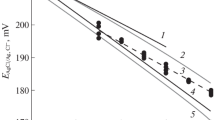Abstract
The low frequency impedance of bare silver electrodes in contact with physiological saline was found to exhibit capacitive reactance and by the deposition of chloride the impedance became resistive in nature. It was found that a chloride deposit of 100–500 mA.sec/cm2 of electrode area provided the lowest electrode-electrolyte impedance. Prolongation of chloriding beyond this range increased the electrode-electrolyte impedance at all frequencies but did not alter the resistive nature of the impedance. To achieve a chloride deposit which is proportional to the product of mA and sec it was found that a minimum chloriding current density of 5 mA/cm2 of electrode area should be used.
Sommaire
L'impédance à basse fréquence d'une électrode d'argent pur, plongée dans du sérum physiologique, présente une réactance capacitive, alors qu'elle devient résistive après dépôt de chlorure. Il a été montré qu'un dépôt de chlorure de 100 à 500 mA. sec/cm2 présente l'impédance électrode-électrolyte la plus faible. Au-delà de cette valeur, l'impédance croît à toutes les fréquences, mais sa partie résistive reste inchangée. Pour obtenir un dépôt de chlorure proportionnel au courant produit et au temps écoulé, on a montré que la densité du courant minimum doit être de l'ordre de 5 mA/cm2 d'électrode.
Zusammenfassung
Die Niederfrequenzimpedanz reiner Silberelektroden im Kontakt mit physiologischer Kochsalzlösung zeigte kapazitiven Widerstand. Nach Chloridablagerung wurde die Impedanz resistiv. Die Messungen ergaben bei einer Chloridschicht von 100–500 mA.sec/cm2 Elektrodenfläche die niedrigste Elektroden-Elektrolyt-Impedanz. Eine Verlängerung der Chloridierung über diesen Bereich erhöhte die Elektroden-Elektrolyt-Impedanz bei allen Frequenzen, änderte jedoch nicht die resistive Natur der Impedanz. Um eine Chloridschicht zu erhalten, welche dem Produkt von Milliampere und Sekunden proportional ist, muß nach unseren Messungen eine minimale Chloridierungsstromstärke von 5 mA/cm2 Elektrodenfläche eingesetzt werden.
Similar content being viewed by others
References
Afanasiev, A. S. (1930) Influence of the solvent on the electromotive force of silver-silver halide cells.J. Am. chem. Soc. 52, 3477–3483.
Brown, A. S. (1934) A type of silver chloride electrode suitable for use in dilute solutions.J. Am. chem. Soc. 56, 646–647.
Bures, J., Petran, M. andZachar, J. (1962)Electrophysiological Methods in Biological Research. Academic Press, New York.
Carmody, W. R. (1929) A study of the silver chloride electrode.J. Am. chem. Soc. 51, 2901–2904.
Carmody, W. R. (1929) Studies in the measurement of electromotive force in dilute aqueous solutions. I. A study of the lead electrode.J. Am. chem. Soc. 51, 2905–2909.
Carmody, W. R. (1932) Studies in the measurement of electromotive force in dilute aqueous solutions. II. The silver chloride electrode.J. Am. chem. Soc. 54, 188–192.
Cole, K. S. andKishimoto, U. (1962) Platinized silver chloride electrode.Science, N. Y. 136, 381–382.
Cole, K. S. (1967) Personal communication.
Cooper, R. (1963) Electrodes.Am. J. EEG Technol. 3, 91–101.
Day, J. andLippitt, M. (1964) A long-term electrode system for electrocardiography and impedance pneumography.Psychophysiol. 1, 174–182.
Geddes, L. A. andBaker, L. E. (1967) Chlorided silver electrodes.Med. Res. Engng 6, 33–34.
Goldstein, A. G., Sloboda, W. andJennings, J. B. (1962) Spontaneous electrical activity of three types of silver EEG electrodes.Psychophysiol. Newslett. 8, 10–16.
Greyson, J. (1962) Silver-silver chloride electrodes using optical silver chloride crystals.J. electrochem. Soc. 109, 745–746.
Jahn, H. (1900) Über den Dissociationsgrad und das Dissociationsgleichgewicht stark dissociierter Elektrolyte.Z. phys. Chem. 33, 545–576.
Janz, G. J. andIves, D. J. G. (1968) Silver-silver chloride electrodes.Ann. N.Y. Acad. Sci. 148, 210–221.
MacInnes, D. A. andParker, K. (1915) Potassium chloride concentration cells.J. Am. chem. Soc. 37, 1445–1461.
MacInnes, D. A. andBeattie, J. A. (1920) The free energy of dilution and the transference numbers of lithium chloride solutions.J. Am. chem. Soc. 42, 1117–1128.
O'Connell, D. H., Tursky, B. andOrne, M. T. (1960) Electrodes for recording skin potential.Archs gen. Psychiat. 3, 252–258.
Skov, E. R. andSimons, D. G. (1965) EEG electrodes for in-flight monitoring. SAM-Tech. Rep. TR-65-18. USAF School of Aerospace Medicine, Brooks AFB, Texas.
Smith, E. R. andTaylor, J. K. (1938) Reproducibility of the silver-silver chloride electrode.J. Res. natn Bur. Stand. 20, 837–847.
Taylor, J. K. andSmith, E. R. (1939) Reproducibility of silver-silver halide electrodes.J. Res. natn Bur. Stand. 22, 307–314.
Author information
Authors and Affiliations
Additional information
Supported in part by Grant 5-T1-HE 05125.11, National Heart Institute, National Institutes of Health, Bethesda, Maryland 20014.
Rights and permissions
About this article
Cite this article
Geddes, L.A., Baker, L.E. & Moore, A.G. Optimum electrolytic chloriding of silver electrodes. Med. & biol. Engng. 7, 49–56 (1969). https://doi.org/10.1007/BF02474669
Received:
Issue Date:
DOI: https://doi.org/10.1007/BF02474669




